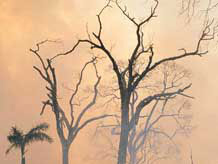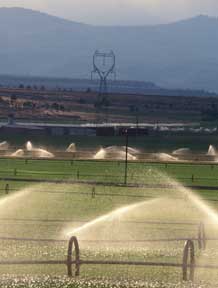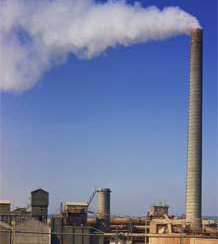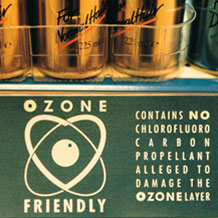Man-made(anthropogenic) greenhouse gases
Since the start of the industrial revolution in the mid-eighteenth century, human activities have greatly increased the concentrations of greenhouse gases in the atmosphere.
Consequently, measured atmospheric concentrations of carbon dioxide are many times higher than pre-industrial levels.
The main sources of greenhouse gases due to human activity are:
- burning fossil fuels leading to higher carbon dioxide concentrations
- farming and forestry — including land use change via agriculture and livestock
- cement manufacture
- aerosols — chlorofluorocarbons (CFCs)
Burning fossil fuels
Carbon dioxide levels are substantially higher now than at any time in the last 750 000 years. Beginning with the industrial revolution in the 18th century, the combustion of fossil fuels has elevated CO2 levels from a concentration of approximately 280 parts per million (ppm) in the atmosphere in pre-industrial times to around 387 ppm today.
Concentrations are increasing at a rate of about 2–3 ppm/year. These increasing concentrations are projected to reach a range between 535 to 983 ppm in the atmosphere by the end of the 21st century.
Together with rising emissions of methane and other greenhouse gases, and the associated feedback effects, it is suggested that these changes may possibly cause an increase of 1.4–5.6°C between 1990 and 2100. Consequently some scientists have suggested setting goals to try to limit concentrations to 450 or 500 ppm.
Farming and forestry

Land use change (mainly deforestation in the tropics) accounts for up to one third of total anthropogenic CO2 emissions.
Agricultural activities such as livestock digestion, manure use, paddy rice farming, land use and wetland changes, pipeline losses, and vented subsurface landfill emissions all lead to higher methane atmospheric concentrations.
The use of fertilizers can also lead to higher nitrous oxide (N2O) concentrations.
Agriculture

Prior to widespread fossil fuel use, man’s largest effect on local climate was to change land use by activities such as irrigation, deforestation, and agriculture.
Land use may alter the local albedo (reflectivity of the Earth’s surface) by reducing vegetation ground cover, altering the way sunlight is absorbed or reflected. It is possible that the climate of Greece and other Mediterranean countries was permanently changed by widespread deforestation (wood being used for shipbuilding, construction and fuel) between 700 BC and 1 AD, with the result that the modern climate of these countries is significantly hotter and drier than it was before.
Similarly, land in Australia was permanently altered shortly after humans arrived some 40 000 years ago when areas of temperate rainforest were burned down to produce grasslands that favoured game that the new inhabitants preferred to eat.
Livestock

According to the United Nations, livestock is responsible for 18 per cent of the world’s greenhouse gas emissions. This percentage includes the effect of deforestation in order to create grazing land, as well as livestock natural methane gas emissions. These include nitrous oxide (which has 296 times the global warming potential of CO2) and methane (which has 23 times the global warming potential of CO2).
In the Amazon rainforest, 70 per cent of deforestation is specifically carried out to create grazing land.
Cement manufacture

Cement manufacture contributes CO2 to the atmosphere when calcium carbonate is heated, producing lime and carbon dioxide. CO2 is also produced by burning the fossil fuels that provide the heat for the cement manufacture process.
It is estimated that the cement industry produces around 5 per cent of global man-made CO2 emissions, of which 50 per cent is produced from the chemical process itself, and 40 per cent from burning fuel to power that process.
The amount of CO2 emitted by the cement industry is more than 900 kg of CO2 for every 1000 kg of cement produced.
Aerosols

Aerosols (particles suspended in the atmosphere), particularly sulphate aerosols from fossil fuel combustion, exert a cooling influence by reducing sunlight.
The use of Chlorofluorocarbons (CFCs) has increased in refrigeration systems, and use of CFCs and halons in fire suppression systems and manufacturing processes.
Reference
Boden, T.A., G. Marland, and R.J. Andres. 2009. Global, Regional, and National Fossil-Fuel CO2 Emissions. Carbon Dioxide Information Analysis Center, Oak Ridge National Laboratory, U.S. Department of Energy, Oak Ridge, Tenn., U.S.A. doi 10.3334/CDIAC/00001








